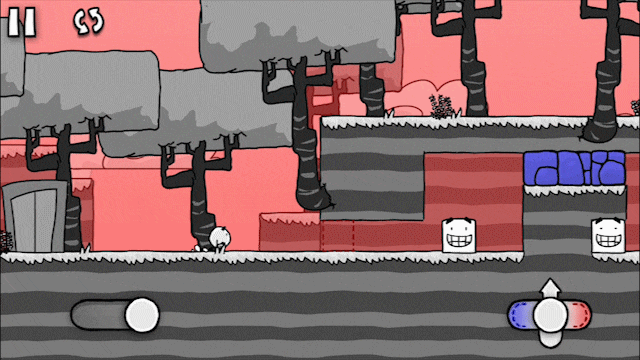
Featured Blog | This community-written post highlights the best of what the game industry has to offer. Read more like it on the Game Developer Blogs.
Lying Through Your Teeth And Other Great Ways To Fix Your Tutorial
Tips on how to make a better tutorial by being a worse person.

The tutorial is one of the most important parts of any game. The tutorial tells players not just how to play your game, but why they should play it. Get it wrong and they'll walk away frustrated. Get it right and you'll instantly gain loyal supporters.
I recently released a puzzle-platformer, Super Happy Fun Block, for iOS. I worked on the game for three years, during which time my tutorial went through a huge number of playtests and revisions. I learned what worked and I learned what didn't work. I learned that even when following great advice, it's very hard to make a tutorial that's actually any good. But it's a little easier if you decide to be bad.
Lesson 1: Lie
Super Happy Fun Block has unique touch screen controls that actually work very well. They’re easy to use and eliminate accidental input. But they had one huge flaw: I could not teach them to anybody. I followed sage advice from great game makers, and I couldn't even teach players how to walk.
Then I had an epiphany: Players don't need to know how to walk. They just need to know a good way to walk. And so a beautiful lie was born: the slider.

Let me explain: To move, players need to slide their thumb on the left side of the screen a short distance in the desired direction, then they just hold their thumb still. The “hold still” was the problem. No animation got the message across and any words were ignored. But the slider solved all of this. It clearly indicated how far to slide the thumb. And when players lifted their thumb off the screen, the slider returned to center and movement stopped - indicating clearly they should have kept their thumb pressed to the screen.
The game requires interacting with this slider to start, ensuring players know it exists and that touching it will make the character move. Except that’s a lie. Once the game actually starts, they can slide their finger anywhere on the left side of the screen. Some people eventually realize this. Others don’t. All can play!
 Note: The first time you play, the slider on the right won't appear upon starting the game.
Note: The first time you play, the slider on the right won't appear upon starting the game.
Lying works so well, I’m going to give another rather different example: Teaching players that some blocks can be pushed. I set up a tunnel for the player to run through. Right at the end of the tunnel is a pushable block. It appears that there is just barely enough room between the end of the tunnel and the gap to jump between the two - clearing the block in your path and continuing on your way. This is the lie. Without hesitation players charge at the block, jump, bump their head, and accidentally push the block out of their way. Lesson learned.

Lesson 2: Steal
The only people who know how your players will interpret your game are your players. Watch them closely. See what assumptions they make and how they assume controls/systems work. If a lot of people naturally come to the same wrong conclusions, maybe those conclusions shouldn’t be wrong.
In Super Happy Fun Block, you can switch between three colors: red, blue, and neutral. This phases out red, blue, or no objects, respectively. To do this you swipe right, left, or down on the right side of the screen. This is indicated clearly by a slider on the right side of the screen (swiping up jumps).
There was a problem though. Players understood they need to swipe right for red… but what does “red” mean? Does this make red objects appear or disappear? I tried various ways of explaining this, including several UI adjustments, but nothing helped. Then a player explained their thought process: “When I swipe right, I’m thinking that I want to do something to red. If red objects are phased in, I want to phase them out. If they’re phased out, I want to phase them in. Either way, I’m thinking about red, see red on the slider, and slide towards it.” Wow, it really should just work that way. And so now it does. Thanks for the idea!
Lesson 3: Give up
In addition to pushing blocks players can pull them. All they need to do first is walk up to a block and grab it. To grab, you tap on the right side of the screen. I could not teach this to the majority of my players.
My first idea was to pop an indicator over the slider that said “tap.” The indicator was pointing right at the slider, but players thought they needed to tap the block - which doesn’t work. Some players were focused on the block they never even saw the indicator. I tried a multitude of ways to teach this to players including trapping them in a room with instructions written on wall. Everything was either misinterpreted or ignored.
So I did what many great people have done before me: I gave up. Instead I made users automatically grab onto any block they pushed. To let go, they just jump - which inevitably every user will naturally try to do. Some people eventually figure out they can still tap the right side of the screen to grab or let go of blocks, but most don’t and that’s fine too.
 Note: You might notice the text on the right instructing players that they can tap to grab or drop the block. Most players don't notice this.
Note: You might notice the text on the right instructing players that they can tap to grab or drop the block. Most players don't notice this.
Congrats! You're now a tutorial making expert.
Well, okay, that's probably not true. There's are lots of good rules to keep in mind when making your tutorial, but other people have already said them better than I ever could (here's an example by George Fan). Of course, every tutorial has its own unique challenges. Nobody can possibly tell you everything you'll need to know, but if you use these lessons well, I hope you'll find making your tutorial work a little easier.
If you're interested in learning more about Super Happy Fun Block, you can check out the website or grab a copy to experience the tutorial for yourself. To stay informed of any updates or additional blogs, you can follow me on twitter.
Read more about:
Featured BlogsAbout the Author(s)
You May Also Like












